By Falco
05 Aug 2024
• The US economy is currently experiencing a marked soft spot, with a notable deterioration in the labour market.
• The Fed continues to make missteps, having missed an opportunity to cut interest rates this past week. The Fed is yet again being behind the curve with its monetary policy.
• Circumstances may force the Fed to cut interest rates by 50bps at the next meeting. We wouldn't rule out the possibility of the Fed cutting interest rates between meetings by 25-50bps if the financial markets go into a tailspin.
• Equities have downside 5-10%
• Bonds are up with events unless the Fed gets spooked and signals more substantial rate cuts in which case yields could drop a further 25bps.
• Be careful with high yield bonds where spreads may probably widen further.
• Safe havens - Gold and defensive equities with yield
Last Friday’s weak US employment report overwhelmed the markets, pushing them over the edge. The resulting reaction of the bond and equity markets signalled that investors were ready to price in a very different outlook for the US economy and asset valuations than they have in the past. However, all hope is not lost yet. Policymakers, particularly the Fed, should respond appropriately. After all, interest rates are at or just below their peak around the world.
We had already cautioned that the flow of US economic data and the second-quarter corporate earnings season led us to believe that the US economy had lost significant momentum. Even before Friday’s poor non-farm payroll numbers, the US economic surprise index was showing stress, standing at one standard deviation below the long-term average.
Chart 1: US Economic Surprise Index Weakens
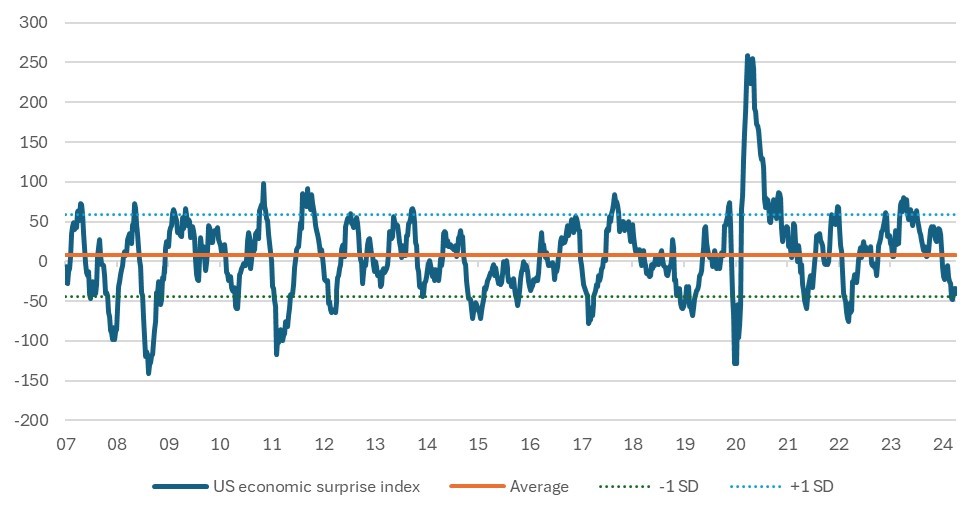
Source: Bloomberg
At its meeting earlier in the week, the Fed had made mention of the labour market as a reason why it might need to cut interest rates in September. Friday’s labour market report was so weak that it had many wondering why the central bank had not already cut the rates. At 114,000, the non-farm payroll numbers compared dismally with the market expectations of 175,000; the unemployment rate rose to 4.3% versus expectations of 4.1%.
A Recession? It’s the ‘Sahm’ feeling.
With the economy adding fewer jobs than expected and unemployment rising, there are indications that a recession may be upon us within the next three months. For instance, take the so-called Sahm rule, which is a measure based on the trend in US unemployment. It is signalling that a recession has already been triggered. Although it is not a forecast, the rule has been correct on every occasion since 1953. However, even Claudia Sahm, after whom the rule is named, is arguing that this time could be different. While it’s important to be vigilant, we should also not get overly negative. It is also worth noting that the Atlanta Fed’s estimate of current trend GDP growth, based on recent economic data releases, is 2.5%.
Friday’s asset market movements were stark in the context of the relatively benign market volatility seen since the start of the year. Some of the questions that investors will have to ask themselves in the coming weeks is if this is the big one that some market participants have long worried about. Also, is this the time the US equity market finally reprices back to what might be considered as the right valuation? For now, investors remain in a dilemma and that dilemma is reflected in Chart 2, which shows the PE multiple of the S&P500 compared to the US 10-year government bond yield. The PE multiple of the US equity market is inordinately high compared to history, given the level of interest rates. Despite the sharp rise in the 10-year yield in 2022-23, the PE multiple of the equity market continued to rise in part because of the continued increase in the tech stocks’ weighting in the index.
Chart 2: S&P500 Still High Versus the 10-Year Bond Yield
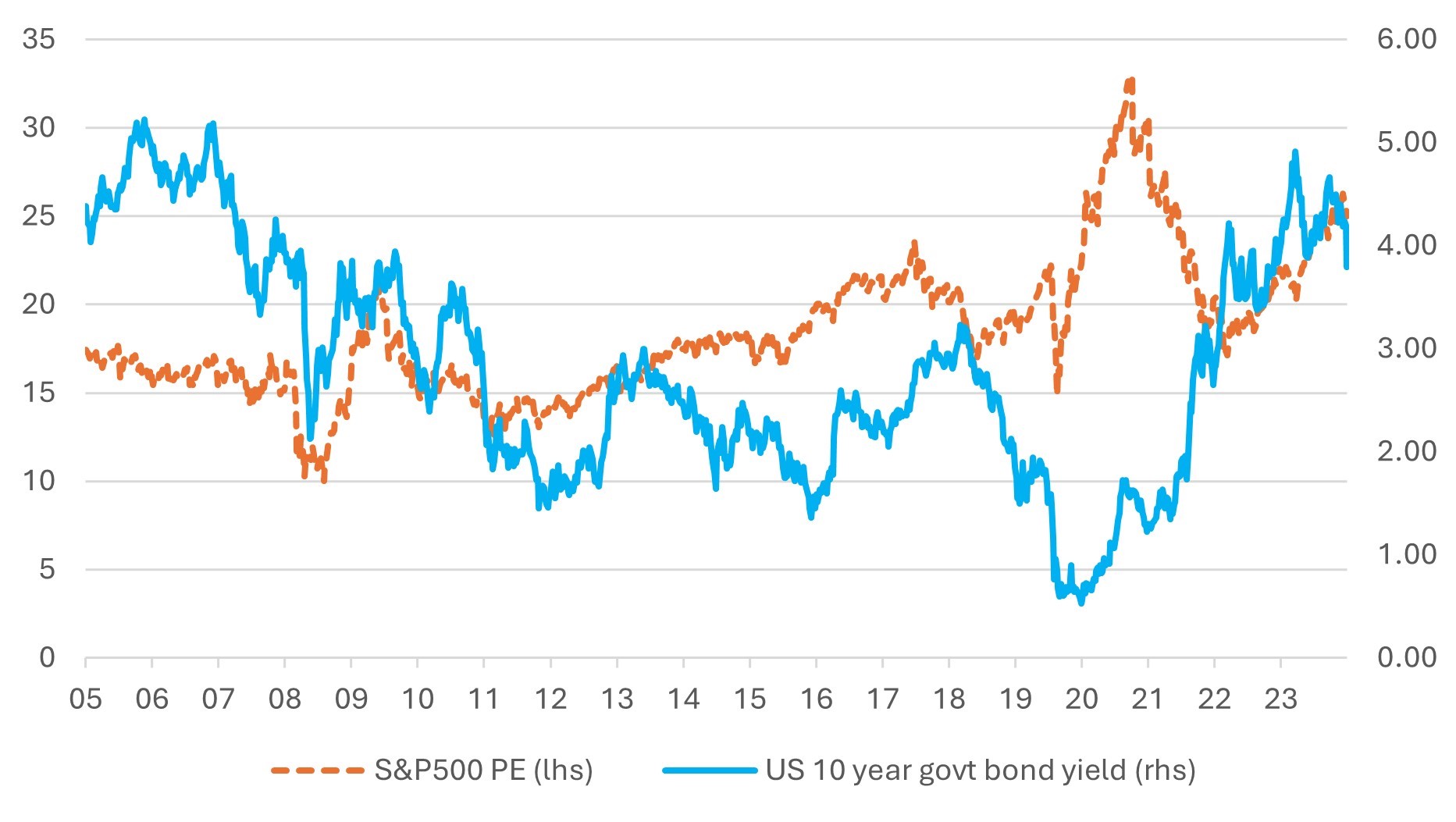
Source: Bloomberg
Tech Appears Vulnerable, But Maybe Not as Much as One Might Think
Data suggests that the recent performance of the tech-heavy NASDAQ Composite has been consistent with the shifts in earnings expectations for the sector. The 20% rise in the index over the past 12 months compares to a 30% increase in corporate profit forecasts. However, the challenge for the sector is that corporate profit forecasts have recently been on a downward trend. Part of the reason for the cuts in forecasts has been a string of disappointing earnings reports in the sector.; for example, Intel, which might be considered an 'old economy' tech stock, reported poor results, due to ongoing problems with its uncompetitive product line up, leading to its shares plunging 30%.
While it's not all bad news for the tech sector, the risk of a recession always puts high PE multiple stocks at risk. Nevertheless, it's important to consider that not all companies within the sector are equally vulnerable despite the NASDAQ Composite currently trading at a PE multiple of 37.0x historic earnings, which might seem high. High-growth tech stocks may still offer opportunities, even in a challenging economic environment.
Chart 3: NASDAQ Forecast Earnings and Index Performance (Rebased to -1Y=100)
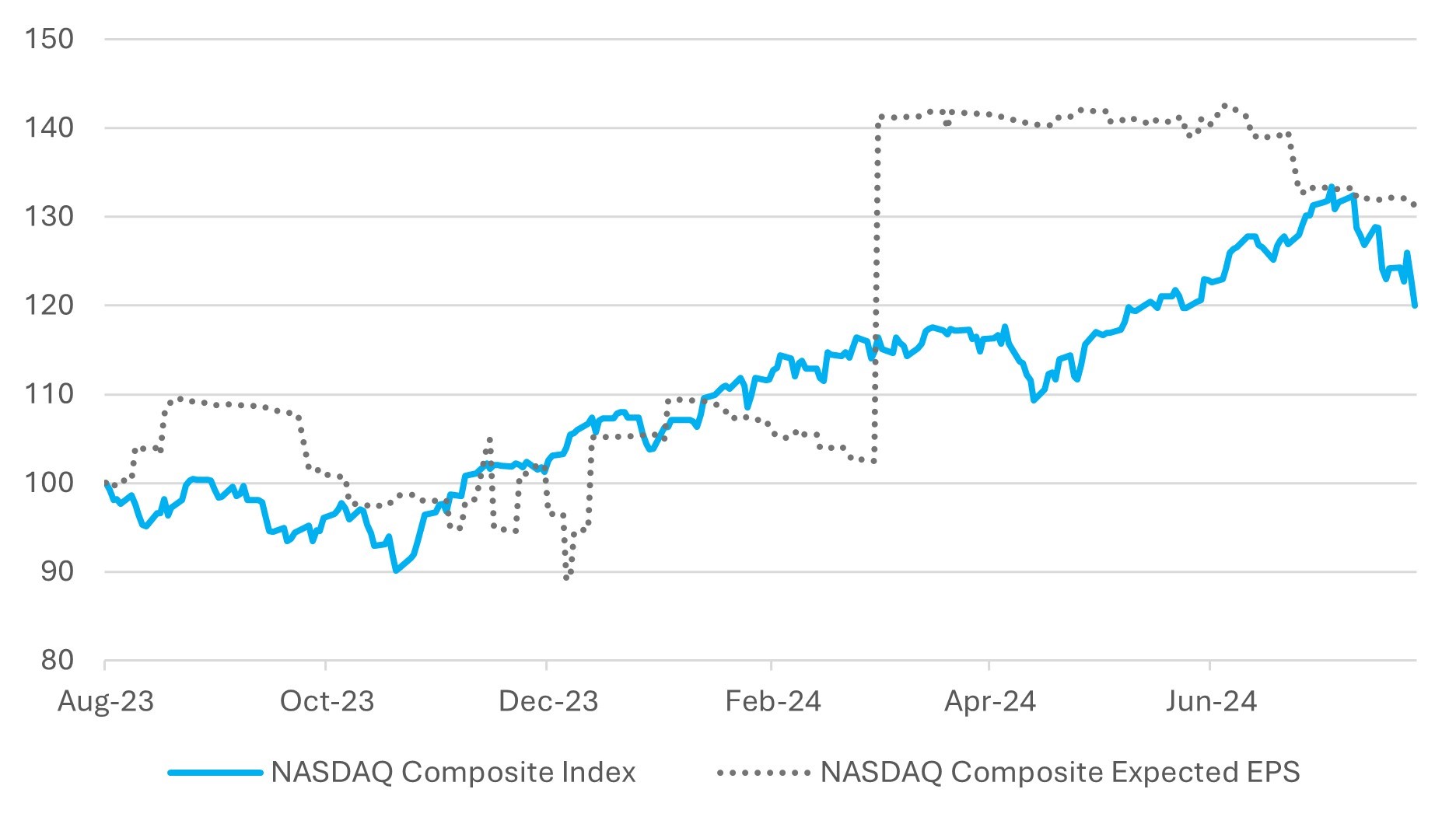
Source: Bloomberg
In these kinds of market conditions, short term sentiment tends to be affected by the market index technicals. Hence, for the S&P500 we can see downside to the 200-day moving average of 5000, implying a further downside of 7%.
Chart 4: S&P 500 – Targeting a Drop to 5000, (200-Day MAV)
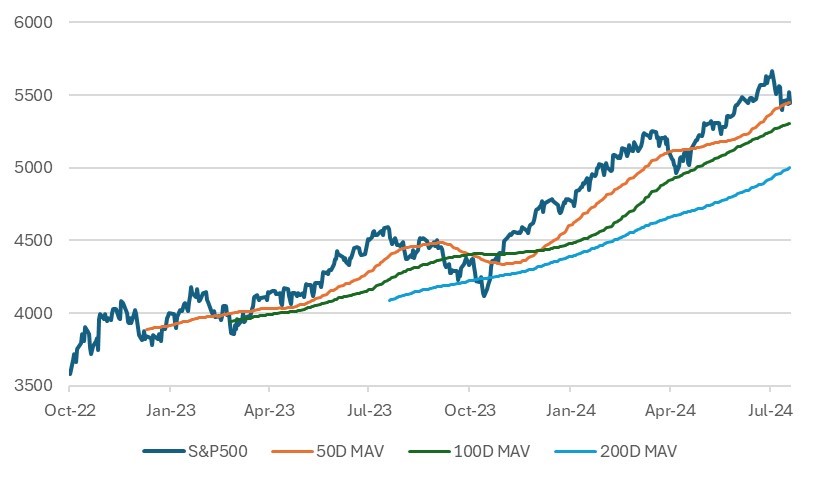
Source: Bloomberg
Before We Get Too Negative: The Fed Could Cut Rates Rapidly
Before we start feeling too pessimistic, it's important to recognize that the Fed has significant room for manoeuvring, given how high interest rates currently are. Real interest rates, adjusted for the current level of inflation, are +250bps. Historically, during recessions, the Fed has cut interest rates to negative real rates.While today's dialogue focuses on the Fed potentially cutting rates by 25bps to 50bps, we should not rule out the possibility of more aggressive action going forward. How about the Fed cutting rates by 200bps over a very short time frame? Such a move could provide a substantial boost to the economy, countering recessionary pressures and supporting market stability.
Chart 5: Real Fed Funds Rate (Adjusted for CPI)
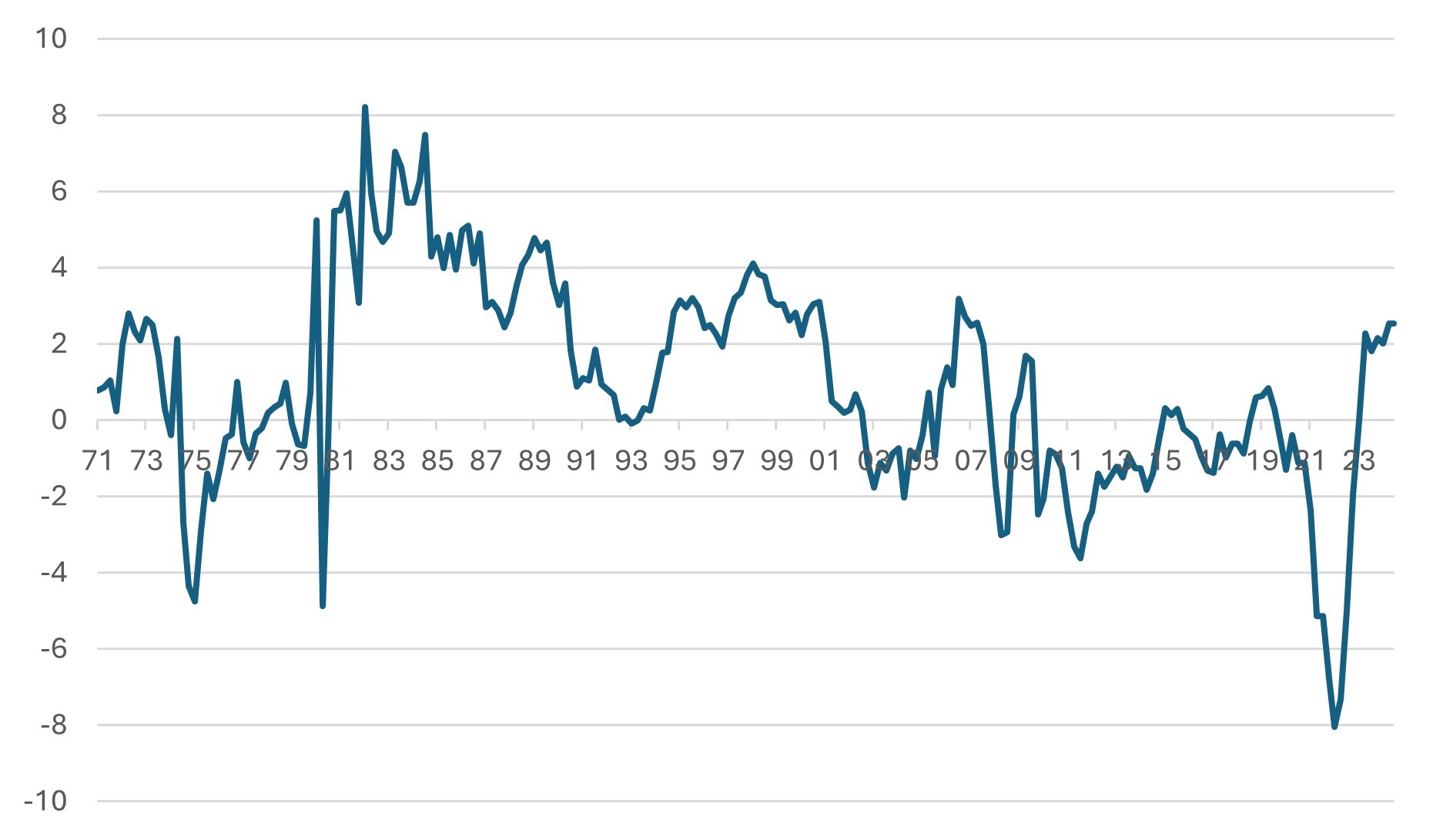
Source: Bloomberg
Asian Equity Markets: Diverging Trends
In Asian equity markets, the sharp sell-off in Japanese equities reflects an equity market grappling with higher interest rates while the rest of the world toys with the idea of cutting rates. The concerns are more profound because the dialogue around cutting interest rates is due to weakening growth, not because inflation has been beaten down.
Chinese equity markets will likely relatively outperform, as they did last week. Valuations are not the challenge in China; the slow pace of policy-making is. However, we suspect the leadership will be even more focused on supporting domestic demand now that the US economy appears at risk of slowing more sharply than previously anticipated. This focus on bolstering domestic demand could provide a cushion for Chinese equities amidst global economic uncertainty. Some government announcements of policy initiatives over the weekend in support for the consumer sector should help.
Government Bonds for Safety and Sharper Rate Cuts
With the talk of recession gaining traction, government bonds are clearly the near-term winner. However, the rally in the 10-year bond yield has already discounted a significant amount of the bad news. Given the current level of the ISM Manufacturing Survey Confidence Index, which serves as a proxy for the state of the economy, the real 10-year bond yield is already at a relatively low level of around 1%. While it could go lower, this typically happens only in the event of a financial market crisis or real economic distress, as seen in 2000 and 1994.
Investors should remain cautious and monitor economic indicators closely. Although government bonds offer a safe haven, their upside may be limited unless the economic situation deteriorates further.
Chart 6: US ISM Manufacturing Sector Survey Index and Real US 10-Year Government Bond Yield
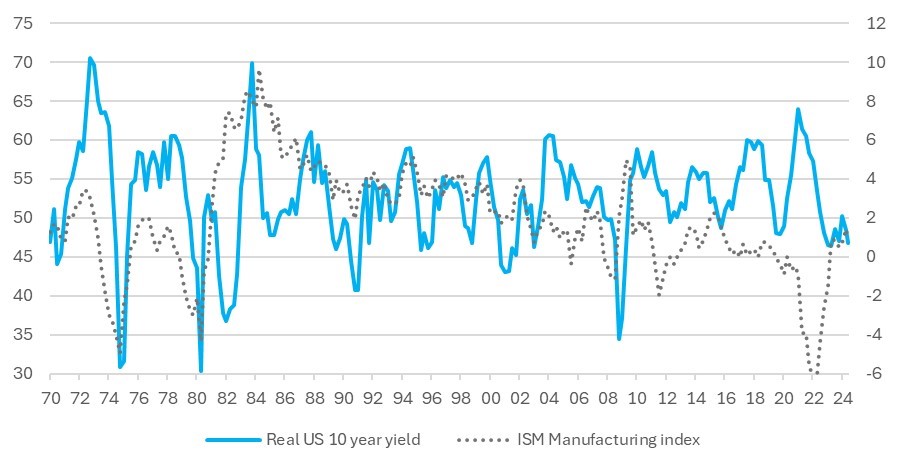
Source: Bloomberg
Market Expectations and Bond Performance
The market is currently pricing in a 67% chance of a first rate cut of 50bps. In response to the market's re-pricing of the Fed rate cuts, the US 2-year bond, which has been our favourite bond in recent weeks, has rallied significantly. The 2-year yield is now 150bps below the current fed funds rate, indicating that several cuts are already priced in.If we are indeed facing a recession, the 2-year bond probably represents good value. However, if the economy stabilises or rebounds, the bond's performance may be seen as having already accounted for the expected rate cuts. Investors should consider their outlook on economic conditions when evaluating the potential value of the 2-year bond in this context
Chart 7: US 2-Year Bond Spread Over the Fed Funds Rate
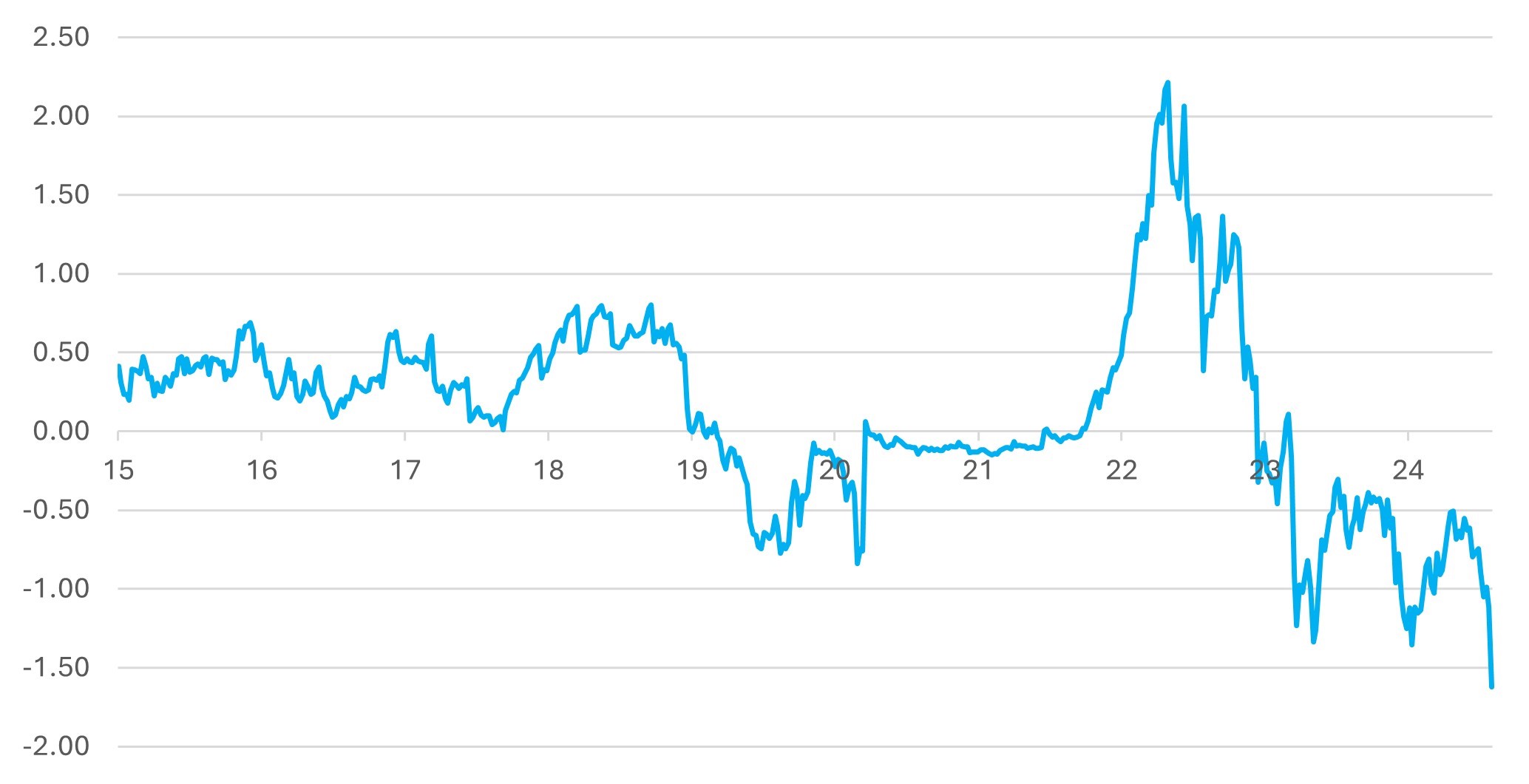
Source: Bloomberg
Just keep an eye on high yield bonds. Spreads moved out smartly at the end of last week and could easily move out a further 50bps.
Chart 8: US High Yield OAS Spread
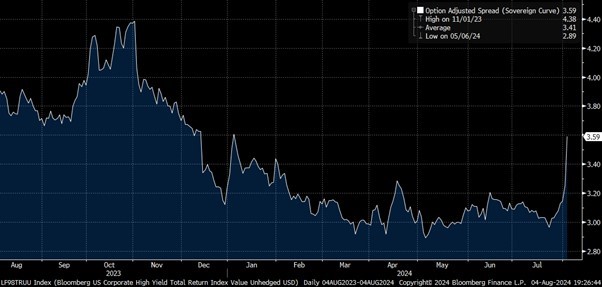
Source: Bloomberg
Gary Dugan - Investment Committee Member
Bill O'Neill - Non-Executive Director & Investor Committee Chairman
5th August 2024
The information contained within is for educational and informational purposes ONLY. It is not intended nor should it be considered an invitation or inducement to buy or sell a security or securities noted within nor should it be viewed as a communication intended to persuade or incite you to buy or sell security or securities noted within. Any commentary provided is the opinion of the author and should not be considered a personalised recommendation. The information contained within should not be a person's sole basis for making an investment decision. Please contact your financial professional at Falco Private Wealth before making an investment decision. Falco Private Wealth are Authorised and Regulated by the Financial Conduct Authority. Registered in England: 11073543 at Millhouse, 32-38 East Street, Rochford, Essex SS4 1DB
